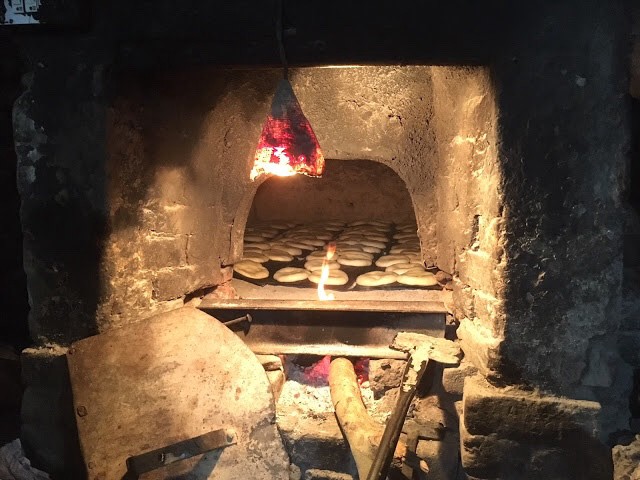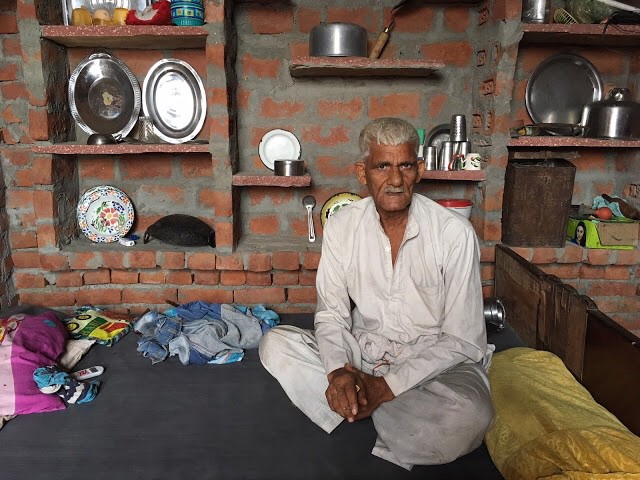
By Meher Ali for TwoCircles.net
Aligarh ki matri or Aligarh ke biscuit, as it is also called, is nothing special to look at: it just looks like a giant cookie, the size of a quarter plate.
But when you bite into it, its taste arguably puts any French biscuit to shame: it is sweet with a subtle taste of spices, especially cardamom, and is usually eaten with butter lathered on top, with your morning cup of tea.
No one knows who invented Aligarh ki matri but the oldest kaarigar or craftsman, as the matri-makers call themselves, that everyone refers back to is Latif Khan.

Khan was born in the late 1890s in Pathano-ki-basti, Gorakhpur, according to his grandson Mohammad Shaffo (65), who was also his student. Making matris was Khan’s “baap-dada ka kaam” or his ancestral work, says Pervez Alam (62), his former pupil. Khan’s other grandson, Abdul Tauheed (46), says that Khan learnt it from his father.
Khan worked in the military in Gorakhpur where he used to bake double rotis, says Shaffo. It would have been the British Indian Army that employed Khan since Gorakhpur, like the rest of India, came under the direct rule of the British after the 1857 Rebellion.
Latif Khan moved to Aligarh after his marriage; Alam conjectures that he or his wife had relatives there. This would have been before 1913, as that is when Khan took on a new student, Rehmat Beg, according to the latter’s son Rahat Beg, himself a kaarigar and owner of Khurram Pappe and Bharat Bakery in Russellganj.
He lived in Sarai Hakim, a neighbourhood right next to Russellganj, where he established a tandoor or earthen oven in his house and started a bakery business from there.

With passed-down knowledge, a tradition begins
Mohammad Shaffo also remembers that his grandfather’s matri workshop was full of students in training to become matri-kaarigars. This included all of Latif Khan’s brothers, his sons, and even his grandsons. Shaffo was ten when his turn came. He even recalls the moment that it happened – he was carrying a pail of water up the stairs when his uncle came up and told him that his grandfather wanted him in his workshop.
Another person to benefit from this passed-down knowledge was Sajid Khan’s father Bundu Khan. Sajid Khan, who is a tailor, says his father was trained at the Sardar Biscuit Factory, established in the 1920s, by a kaarigar called Babu Khan. He, in turn, was taught by Latif Khan’s younger brother Majeed Khan. As a child, Sajid Khan recalls seeing his father carry matris on his bicycle to the Aligarh Muslim University, where it was popular among the students.
But before independence the matri faced stiff competition from the double roti, says Tahir Warsi (90) who worked at the Sardar Biscuit Factory in the 1940s. He said that this was because the British preferred the double roti to matris and they would eat the former with a plate of qorma at noon sharp. After independence was another story as the matri overtook the double roti and went from being a neighbourhood favourite to becoming a town favourite.
Shaffo says that Latif Khan became so famous for his matri that people would bring huge baskets and fill these to the brim to take with them and eat later. This is because matris, like biscuits, can last long if kept in a cool, dry place.
Even after Khan’s death, in the 1970s, matri shops continued to multiply. By the 1980s, there were 50-60 shops selling matris in the Sarai Hakim neighborhood alone, says Mohammad Bashir (55), owner of Azad Bakery, whose brother, Mohammad Suleiman, was Latif Khan’s student.

A special taste
One of the main reasons for the matri’s popularity back then was its unique taste. Kaarigars would add cardamom, nutmeg, and poppy seeds, all of which many can now not afford. Another ingredient was a special masala of 25-30 traditional medicines that the kaarigars would add to curd and then use this mixture to leaven the bread. Though the curd was replaced by industrial yeast 15 years ago, kaarigars continue to use this special masala even today. All of them say that it was invented by a traditional healer by the name of Luqman Hakim.
Luqman is a popular historical figure, also referred to as “Luqman the Wise”, whose proverbs are part of pan-Islamic folklore. One can also find YouTube videos that talk about his medicinal teachings, including on plant-based remedies. Tauheed, however, disagrees saying that it was not Luqman but Latif Khan’s family who came up with the recipe; the latter used to prepare the masala himself by hand.
Whatever the origin, each kaarigar I spoke to said that they had the recipe for this masala written down on a piece of paper, although none ever showed it to me. All of them said that this recipe had been passed down to them by their ustad or teacher. In most cases, the ustad was Latif Khan.
Matri making is long, hard work. When they used curd to leaven the bread, it took kaarigars three days to make matris. But even now, after having switched to industrial yeast, it takes them an average of 16 hours, says Alam who now works at Taj Bakery, in Upar Kot, a ten-minute walk from Sarai Hakim.
A kaarigar spends more than an hour kneading the dough, another hour tossing it, three hours cutting it into individual pieces, and about four hours rolling each into a flatbread.

Yet the kaarigars’ wages are less than the Rs 400 a daily-wage bricklayer earns for an 8-hour workday, says Alam. As a result, most kaarigars do not plan on passing on their knowledge of making matris to their children. Mohammad Nizamuddin (28), co-owner of Taj Bakery, says he continued working as a kaarigar on his father’s advice and now, after his death, wants to continue the family name. But when I ask him if he will teach his children, he says: “Nahi nahi, bilkul bhi nahi.” (No. Absolutely not).
In his five decades as a kaarigar, Alam says his children have grown up watching him come home at all hours of the night, dead tired. They don’t see any reason to learn this work. “Door bhaagte hai,” he says. (They run away from it.) The kaarigars are also aging. Nizamuddin was one of the only ones in his 20s. His brother, Mohammad Fakhruddin (26), says that the average age of a kaarigar is sixty. Most whom I met were not less than 50 years old. “15 saal maan lo,” he says. (Give it 15 years). Once they pass away, this knowledge goes with them.
Listening to the khameer
As Alam rolls a piece of dough into a perfect circle, he recalls one of Khan’s tips: “Khameer batayegaa ki main kaise chal raha hoon.” (The fermented bread will tell you how it’s cooking.)
What Khan meant, Alam says, is that a kaarigar who trains himself to listen to an almost imperceptible “chu, chu” sound that the khameer makes when it is rising, will always be able to gauge if it is cooking too slowly or too fast.
For now though, for Alam, it is yet another day of making matris.
Latif Khan passed away at the age of eighty in the late 1970s.

Meher Ali is an independent journalist based in Aligarh. This article was originally published on meheraligarh.blogspot.com and on her personal Medium blog.

